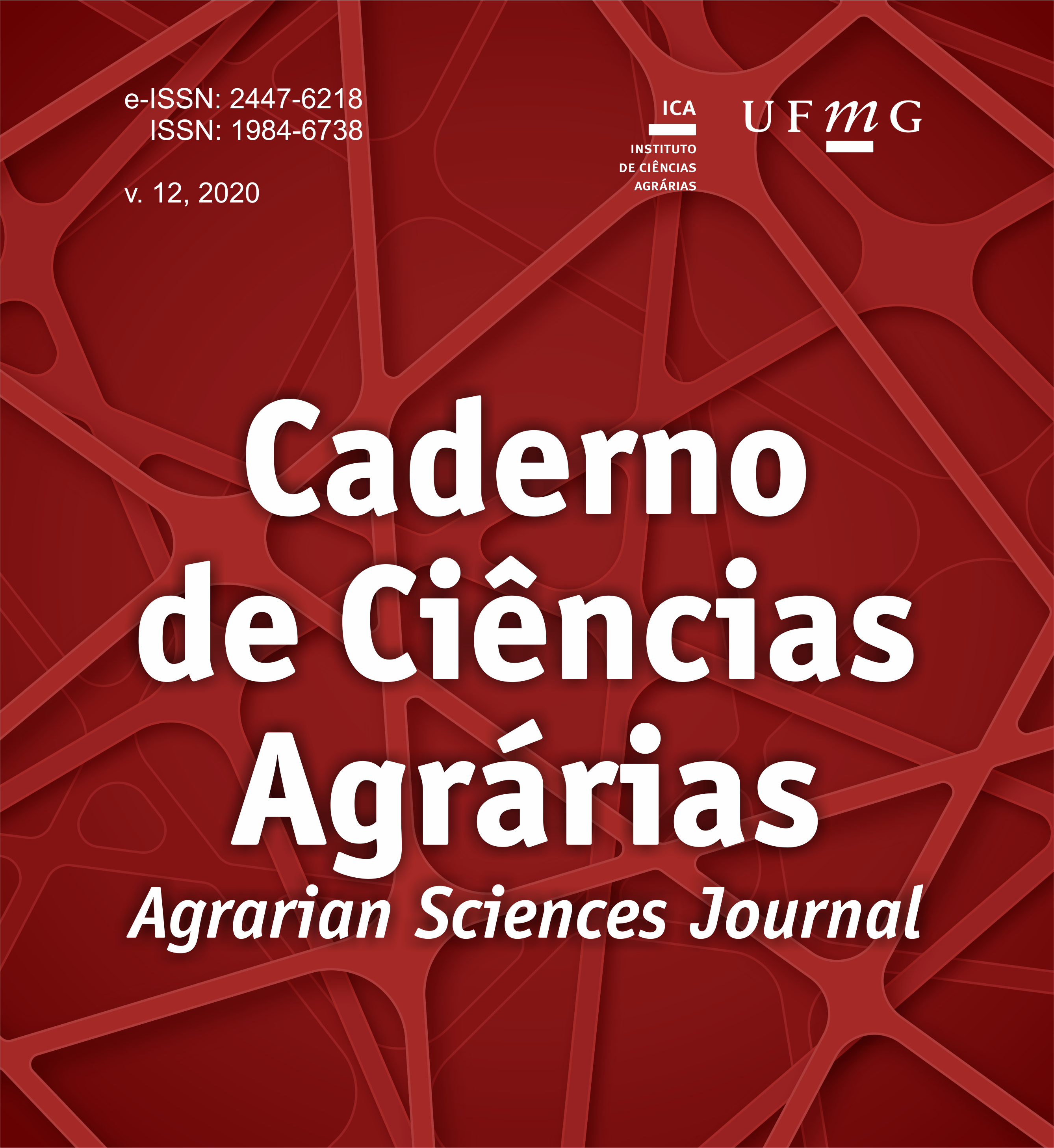Rendimento de queijo tipo Camembert com adição de extensores de proteínas com e sem mexedura da massa
DOI:
https://doi.org/10.35699/2447-6218.2020.15989Palavras-chave:
Proteína lactea, Transferência de sólidos, Perda de peso, Perda de proteínaResumo
Foi avaliado o uso de concentrado proteico lácteo (dairy protein concentrate - dpc) e o papel da agitação em massa no rendimento de fabricação do queijo tipo Camembert. Foram utilizados dois concentrados de proteína de soro e dois de proteínas de leite. A agitação ou não da massa em parcelas subdivididas, em esquema nos tratamentos também foi avaliada. A caracterização do leite foi avaliada em relação aos seus valores médios. A composição química dos queijos; perda de gordura e proteína no soro de leite; coeficiente g / L; rendimento em L / kg, também foram examinadas. A adição de dpc, não promoveu diferença ao rendimento, não influenciou isoladamente na composição do queijo e na perda de gordura no soro, promoveu menor perda de proteína no soro nos tratamentos com proteína do leite, na transferência de sólidos. A agitação ou não da massa não alterou o rendimento, influenciado de forma isolada no teor de gordura do queijo, apresentando-os sem agitar os valores mais altos, não influenciou de forma isolada na perda de gordura no soro de leite. Os tratamentos M1 e M2 apresentaram menor perda de proteína e gordura no soro de leite. Sugere-se fabricar queijos sem mexer, reduzindo de 30 a 40 minutos o tempo de fabricação.
Referências
Brasil. Ministério da Agricultura, Pecuária e Abastecimento. 2006. Instrução Normativa nº 68 de 12 de dezembro de 2006. Available in: http://www.in.gov.br/materia/-/asset_publisher/Kujrw0TZC2Mb/content/id/29896222/do1-2018-07-13-instrucao-normativa-n-30-de-26-de-junho-de-2018-29896212.
Brasil. Ministério da Agricultura Pecuária e Abastecimento. 2011. Instrução Normativa nº 62, de 29 de dezembro de 2011. Available in:: https://cienciadoleite.com.br/noticia/151/instrucao-normativa-n--62-de-29-de-dezembro-de-2011
Callaman, T. 1991. Recovery of milk constituents in cheesemaking (relation to process control). Internatational Dairy Federation, Brussels.
Caro, I, Soto S, Franco MJ, Meza-Nieto M, Alfaro-Rodríguez RH and Mateo J, 2011.Composition, yield, and functionality of reduced-fat Oaxaca cheese: effects of using skim milk or a dry milk protein concentrate. Journal of Dairy Science, 94:580–588. Doi: https://dx.doi.org/10.3168/jds.2010-3102
Costa Júnior, L. C.G. 2006. Uso de extensores na fabricação de queijo Minas frescal. Lavras: Universidade Federal de Lavras. Thesis .Doctor in Food Science. Available in:http://repositorio.ufla.br/jspui/bitstream/1/3132/1/TESE_Uso%20de%20extensores%20na%20fabrica%C3%A7%C3%A3o%20de%20queijo%20minas%20frescal.pdf
Dias, G. 2007. Influência do uso de Geotrichum Candidum, nas características físico-químicas e sensoriais do queijo tipo camember. Viçosa: Universidade Federal de Viçosa .Dissertation .Master in Food Science and Technology.Available in: https://www.locus.ufv.br/handle/123456789/2826.
Emmons, D. B. 1993. Economic importance of cheese yield. Factors affecting the yield of cheese. Ed. D.B. Emmons, Brussels.
Everard, C.D.; Callaghan, D. J. O.; Mateo, M.J.; Donnell, C.P.; Castillo, M.; Payne, F.A. 2008 Effects of cutting intensity and stirring speed on syneresis and curd losses during cheese manufacture. Journal of Dairy Science,91:2575-2582. Doi: https://dx.doi.org/10.3168/jds.2007-0628.
Fennema, O.R.; Parkin, K.L.; Damodaran, S. 2010. Química de Alimentos de Fennema. 4 ed. Artmed, Porto Alegre.
Furtado, M.M.; Lourenço Neto, J.P. 1994. Tecnologia de queijos: manual técnico para a .produção industrial de queijos. Dipemar Editora, São Paulo.
Furtado, M.M. 2005. Principais problemas dos queijos: causas e prevenção. Fonte Comunicações, São Paulo.
Furtado, M.M. 2003. Queijos finos maturados por fungos. Ed. Milk Bizz, São Paulo.
Lucey, J.; Kelly, J. 1994. Cheese yield. International Journal Dairy Technology. 47:1–14.Doi: https://doi.org/10.1111/j.1471-0307.1994.tb01264.x
Mcsweeney, P. L.H.; Fox, P.F. 2004. Metabolism of residual lactose and of lactate and citrate. In: Cheese: Chemistry, Physics and Microbiology. Eds. Fox, P.F.; Mcsweeney, P. L. H.; Cogan, T. M.; Guinee, T. P. Elsevier, London, pp. 361–372.
Mietton, B.1991. Courses on Cheesemaking Technology. National Dairy School of Poigny, Poligny, France.
Milkpoint. 2014. Valor Econômico. Mercado de queijos cresce no país e atrai estrangeiros. Available in: https://www.milkpoint.com.br/noticias-e-mercado/giro-noticias/mercado-de-queijos-cresce-no-pais-e-atrai-estrangeiros-91686n.aspx?r=755629300#.
Pereira, A. C. P. 2014 Características físicas, químicas e microbiológicas de queijos tipo Brie e tipo Camembert produzidos no Brasil. Ponta Grossa: Universidade Estadual de Ponta Grossa Dissertation. Master in Food Science and Technology. Available in: https://tede2.uepg.br/jspui/handle/prefix/635.
SAS- Statistical Analysis System, User‘s guide: version 9.0. 2001. 40 ed. SAS, institute, INC, North Caroline.
Spinnler, H. E.; Gripon, C. 2004Surface mould-ripened cheeses cheese: chemistry, physics and microbiology. In: Cheese: Chemistry, Physics and Microbiology. Eds. Fox, P.F.; Mcsweeney, P. L. H.; Cogan, T. M.; Guinee, T. P. Elsevier, London, pp. 25-68.
Tamine, A. Y.2009. Dairy Powders and Concentrated Products. Wiley-Blackwell, United Kingdom.
USDEC. United States Dairy Export Council. 2002. Características, funções e novas aplicações das proteínas do soro e suas novas frações. Food Ingredients 17:50-56.
Viotto, W.H.; Cunha, C.R. 2006.Teor de sólidos do leite e rendimento industrial. In: Albenones, J. M.; Dürr, J. W.; Coelho, K. O (Ed.). Perspectivas e avanços da qualidade do leite no Brasil. Goiânia: Talento, p. 241-258.
Yada, R.Y. Protein in Food processing. Woodhar Publishing, England.
Downloads
Publicado
Edição
Seção
Licença
Copyright (c) 2020 Caderno de Ciências Agrárias

Este trabalho está licenciado sob uma licença Creative Commons Attribution 4.0 International License.
Autores que publicam nesta revista concordam com os seguintes termos:
Os Direitos Autorais para artigos publicados nesta revista são de direito do autor. Em virtude da aparecerem nesta revista de acesso público, os artigos são de uso gratuito, com atribuições próprias, em aplicações educacionais e não-comerciais.
A revista se reserva o direito de efetuar, nos originais, alterações de ordem normativa, ortográfica e gramatical, com vistas a manter o padrão culto da língua e a credibilidade do veículo. Respeitará, no entanto, o estilo de escrever dos autores.
Alterações, correções ou sugestões de ordem conceitual serão encaminhadas aos autores, quando necessário. Nesses casos, os artigos, depois de adequados, deverão ser submetidos a nova apreciação.
As opiniões emitidas pelos autores dos artigos são de sua exclusiva responsabilidade.







